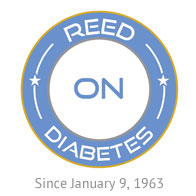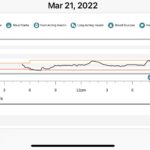This month I took another walk with closed loop tech. The first was with Medtronic’s 670G in 2017 and then the Loop IOS app with an older Medtronic pump & Riley link. This third attempt was with a TSlim X2 pump loaded with Control IQ.
The ride was like a hockey stick. Impressively smooth sailing until meals and then skyrocketing numbers after eating.
The Good
The most impressive aspect of Control IQ is the way basal rates moderate to avoid going low. And the way basal insulin restarts at a reduced rate to keep blood sugars level is uber impressive. I LOVE this aspect of closed loops and Control IQ does it really well. This was my favorite aspect of the first gen Medtronic 670g, although it didn’t kick in basal rates as quickly as Control IQ.
The Bad
Similar to my experience with Medtronic’s 670g back in 2017, my postprandial (after meal) blood glucose levels looked like a rocket ship into space. Especially after dinner when I consume most of my carbs and my basal rate is at its’ lowest. It was a lot of work and time to get #s back in a reasonable range. Here’s a visual of one day from my Dexcom Clarity App:
And while the peak # of 250+ at 9:30pm may not seem especially high, it included a large quantity of manual boluses to beat it down. Without them the number would have been well above 300. (And I don’t do 300!)
So why the elevated blood glucose after meals? I’m not completely sure, but here are my hunches:
Moderated basal rates
Control IQ kept me from going low as it either reduced my basal rate or stopped it completely throughout the day, especially in the afternoon. Less active basal insulin going into dinner could explain part of the quick elevation in blood sugars after eating.
Insulin Duration
Control IQ is hard coded with a 5-hour active insulin assumption. My research revealed that the Control IQ was designed (and FDA approved) with a conservative assumption in order to reduce insulin stacking and avoid hypoglycemia (going low).
My open loop setting for insulin duration is 3 hours. So … Control IQ thinks I have more active insulin available than what I’m accustomed to in an open loop setting.
Target Blood Glucose and Sleep Activity Mode
Like others with tight control, I programmed Control IQ to be in sleep activity mode from 12:01am to 11:59pm. Sleep mode has a target of 110-120, lower than Normal Mode of 112 – 160. Unfortunately, I also realized that Control IQ doesn’t provide correction boluses in Sleep Mode.
Correction Boluses
If glucose values are predicted above 180mg/dl, Control IQ targets a correction bolus at 110. But to be conservative and avoid hypoglycemia, only 60% of the correction bolus is delivered. And only one correction bolus per hour is permitted. I didn’t receive these as Control IQ doesn’t allow correction boluses in sleep mode. Grrr …
Decision
I’m out of warranty with my current pump and I was eager to try Control IQ. It’s a NO for me. I’m not willing to give up my tight control (my most recent A1Cs are 5.5 and 5.8). I also didn’t feel right. Physically my lips were dry and my body felt out of sync. Mentally I was consumed – and stressed – with the high blood sugars after eating carbs. I avoided eating, which made me super hungry (my wife might say hangry!) and restarted the cycle when I finally ate after blood sugars trended down.
Next Steps
I started researching other products on the horizon and found that Medtronic’s 780G product – available now in Europe – has different solutions in the areas I believe were causing my high blood sugars after meals. Here’s how the 780G is different in Europe:
- Targeted Blood Glucose: user selects from targets of 100, 110, or 120
- Correction Boluses: provides up to 12 correction boluses per hour. The correction bolus delivers 100% of units.
- Insulin Action Time: programmable between 2 and 8 hours of insulin action (or duration) time.
I plan to try the 780G when it makes its’ way to the US. Additionally, here’s a link to an article from Italy that compares the two systems: https://www.frontiersin.org/articles/10.3389/fendo.2021.802419/full
On Design
Another consideration in my decision is the look and feel of the pump body and the ease of using the operating systems. Tandem is the hands down winner here. It’s a beautiful looking device, small enough to be stored almost anywhere, and the software is driven by on screen touches (similar to smart phones). I, however, prefer tactile button feedback. The Medtronic pump has physical buttons that are pressed to navigate screen menus. Unfortunately, I find the Medtronic pump body large and clunky, especially when compared to the TSlim and prior generation Medtronic 5 series pumps that I’ve used.
Before closing I should mention the mental aspects of closed looping. With data from blood meters and CGMs, people with diabetes have been empowered to make decisions on when and how much insulin to achieve our blood glucose results. It’s basic math, but it requires constant attention. Every day – almost all day – I think about how much insulin I have on board and how much of it I need to work with the carbs I consume. Oh and there’s exercise that factors into the equation.
Releasing and trusting those decisions to tech is a big leap. I have been an early adopter of advances in treatment methods throughout my life with diabetes. Like other innovations, I will embrace a closed loop solution when it can reliably deliver results better than my open loop methods. Only then will I start to trust and have confidence in a closed loop. When that happens (*), A LOT of mindshare will be regained. And that will be an amazing improvement in my quality of life.
This chapter of my diabetes is still open as there is simply too much promise in closed loop systems … here’s to continuing my closed loop journey.
(*) I remember the excitement and frustration with first generation CGMs. They had much promise, but I didn’t trust the first CGM I used in 2006 … it wasn’t reliable and veered off course too often. It’s now 2022 and I trust my CGM because it’s now reliable (and the FDA agrees). Will it take 15 years to build trust in a closed loop solution?


